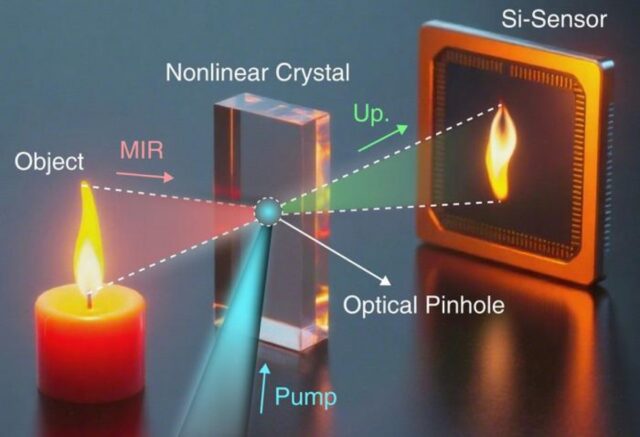The MIT team proposed that a BEC of radioactive atoms—say, rubidium-83—could radioactively decay in sync to produce a laser beam. Neutrinos are released naturally during radioactive decay, and in the quantum BEC state, that decay should accelerate, an effect that should produce an amplified beam of neutrinos akin to how stimulated emission amplifies photons to produce a conventional laser beam. The next step is to build a tabletop demonstration of the concept. If that works, the team envisions using neutrino lasers as a new tool for underground communication and as a source of radioisotopes for medical imaging and cancer diagnostics.
Physical Review Letters, 2025. DOI: 10.1103/l3c1-yg2l
Reviving the pinhole camera for IR imaging

Credit:
Kun Huang, East China Normal University
The earliest forms of the pinhole camera have been around for millennia, dating as far back as the 4th century BCE in China. Light passes through a tiny hole punched into a light-proof box, projecting an inverted image of the scene outside onto the opposite interior wall. Lens-based imaging is prone to distortion and has limitations on depth of field and wavelength. So scientists have revived the pinhole technology to create a prototype pinhole camera for infrared imaging, according to a paper published in the journal Optica.
To make their IR pinhole imaging system, the authors used a laser to create an optical hole inside a nonlinear crystal with a “chirped-period” structure capable of gathering light rays from a wide range of directions, resulting in a wider field of view. The crystal’s unique optical properties essentially convert infrared images into visible light, making it possible for a standard silicon camera to record those images. The process also naturally suppresses noise, so it can work even in low-light conditions.
To test their prototype, the team used 3D time-of-flight IR imaging to image a matte ceramic rabbit and reconstruct its 3D shape by synchronizing ultrafast pulses. The IR pinhole camera can even be adapted to far-infrared or terahertz wavelengths. It’s still very much in the proof-of-concept stage, but once their innovation makes IR imaging systems more affordable, portable, and energy-efficient, the authors envision applications in night vision, industrial quality control, and environmental monitoring, among other uses.
Source link

